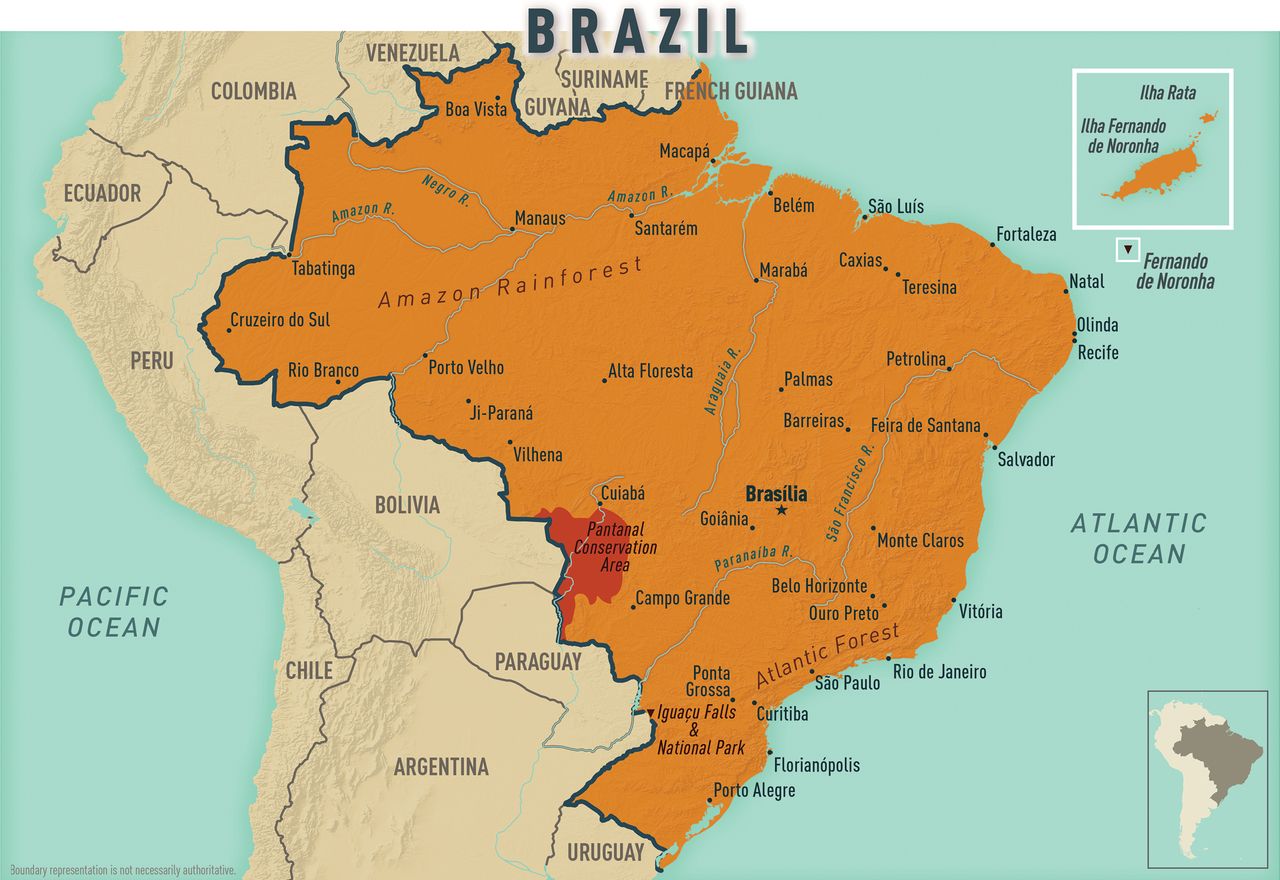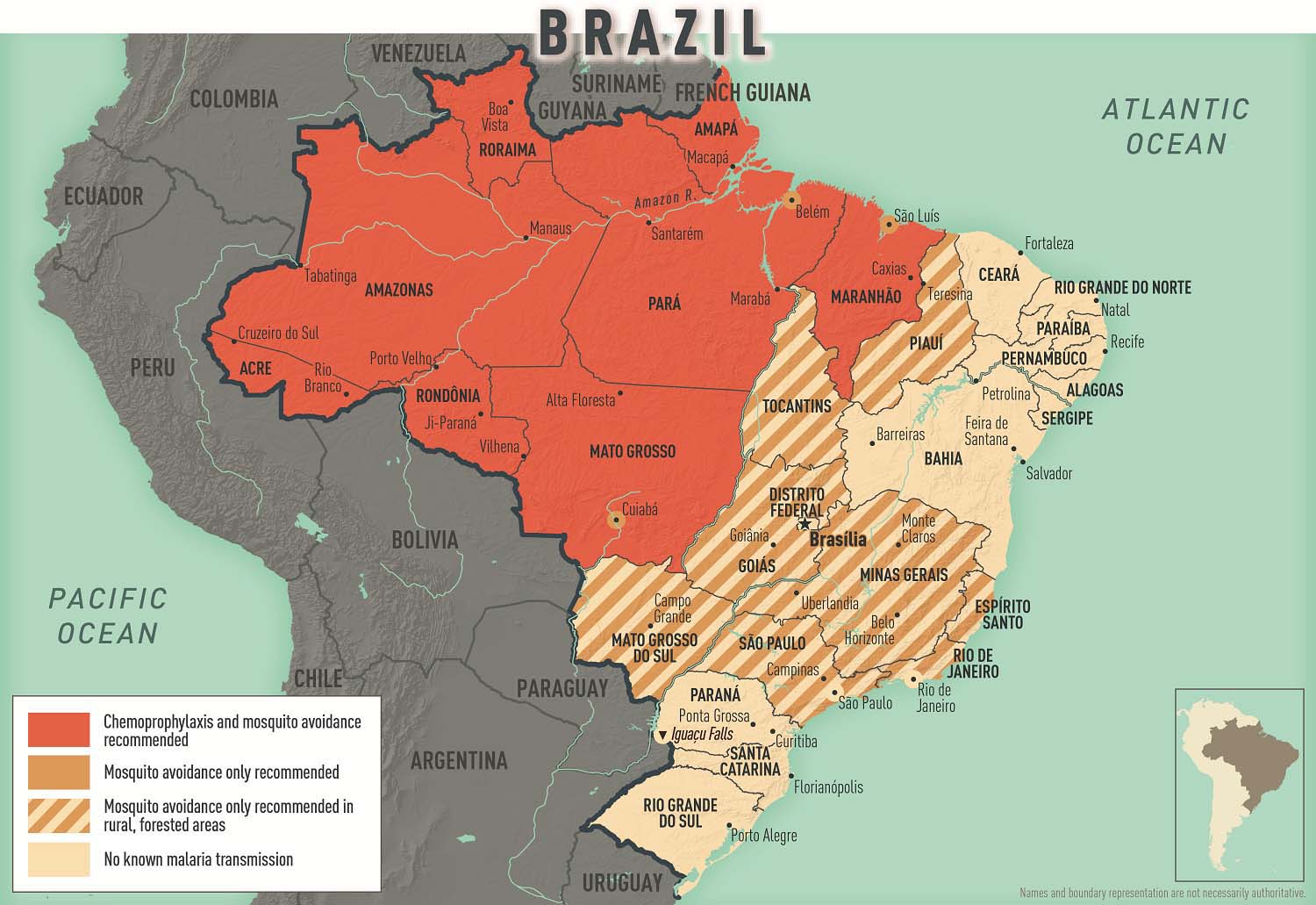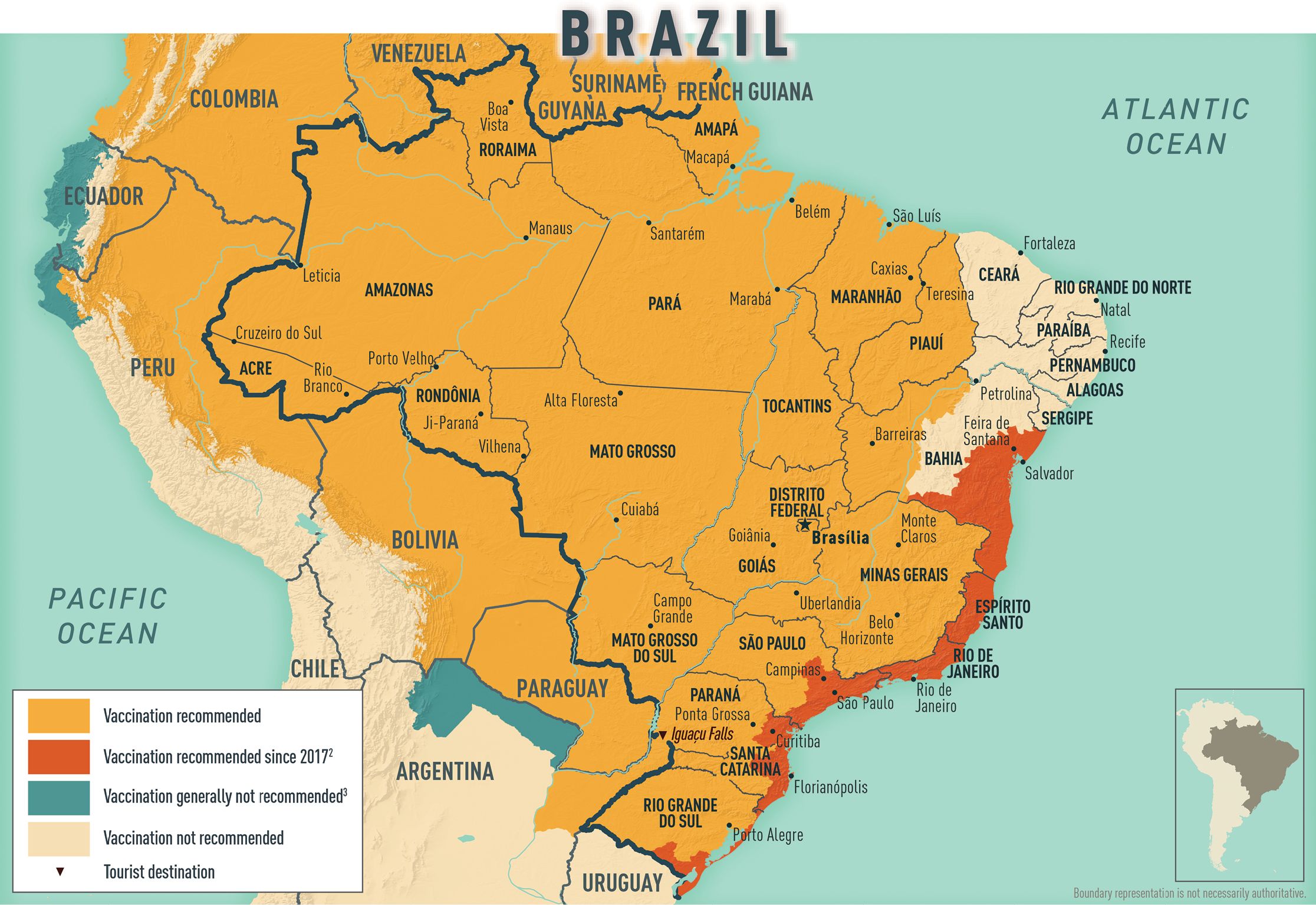Brazil
CDC Yellow Book 2024
Popular ItinerariesDestination Overview
At nearly 3.3 million square miles in size, Brazil is the fifth largest country in the world and the largest country in South America, occupying nearly half the land area of the continent. With >210 million people, Brazil is home to the world’s largest Portuguese-speaking population. The world’s eighth largest economy, Brazil is classified as an upper-middle-income country. Nearly 85% of Brazilians live in urban areas.
Brazil is the most popular tourist destination in South America, and the second most popular in all Latin America. In 2018, >6 million international visitors traveled to Brazil; the country hosted the Fédération Internationale de Football Association (FIFA) World Cup in 2014 and the Summer Olympic and Paralympic Games in 2016. Rio de Janeiro, Brazil’s second-largest city (population >7 million) and most frequently visited tourist destination, is famous for its beaches, landmarks, and annual Carnival festivities. São Paulo, one of the world’s largest cities with >21 million people in the greater metropolitan area, is the economic center of Brazil and the most visited destination for business travel. Brazilian people prize many of their major cities, including Florianópolis, Fortaleza, Manaus, Recife, and Salvador, for their coastlines and regional culture.
The country also boasts multiple UNESCO World Heritage sites, including Iguaçu National Park in Paraná, home to the largest waterfalls in the Americas; the historic towns of Olinda (Pernambuco), Ouro Preto (Minas Gerais), Salvador (Bahia), and São Luis (Maranhão); the modern capital of Brasília; and natural areas of the Amazon Forest and the Pantanal Conservation Area, which extends from one state (Mato Grosso do Sul) into another (Mato Grosso) and into portions of two countries (Bolivia and Paraguay). The Atlantic forests and the archipelago of Fernando de Noronha in the Atlantic Ocean are World Heritage sites (see Map 10-06).
The Amazon Forest, large portions of which extend into the countries that neighbor Brazil, attracts travelers in search of exotic adventures. The region presents unique risks, and careful planning and attention to travelers’ health needs before, during, and after the trip is critical. Because mosquito-borne diseases (chikungunya, dengue, malaria, yellow fever, and Zika) are endemic throughout the Amazon, advise travelers to complete all relevant vaccinations and provide them with detailed instruction on the proper use of chemoprophylaxis and mosquito avoidance. The hot and humid climate throughout the forest increases the risks for dehydration and heat stroke; travelers should practice extreme caution and, whenever possible, resist the temptation to consume potentially unsafe food and beverages.
Infectious Disease Risks
Travelers to Brazil should be up to date on routine vaccines, including coronavirus disease 2019 (COVID-19), influenza, measles-mumps-rubella (MMR), and diphtheria-tetanus-pertussis. Hepatitis A vaccination also is recommended. Consider hepatitis B vaccination for most travelers, but especially for anyone who could be exposed to blood or other body fluids (e.g., through medical services, sexual contact, tattooing).
Enteric Infections & Diseases
Travelers’ Diarrhea
Travelers should take food and water precautions throughout Brazil, including in the big cities (see Sec. 2, Ch. 8, Food & Water Precautions). Travelers’ diarrhea (TD) is the most common travel-related ailment, and visitors consuming raw fruits and vegetables, unpasteurized dairy products, and food from street vendors increase their risk for foodborne infections. Oral rehydration salts are available from public health clinics and in almost all pharmacies in Brazil. For further information about travelers’ diarrhea, see Sec. 2, Ch. 6, Travelers’ Diarrhea.
Typhoid Fever
Consider vaccinating “adventurous eaters” against typhoid, along with travelers who stay with friends or relatives or who visit smaller cities, villages, or rural areas (see Sec. 5, Part 1, Ch. 24, Typhoid & Paratyphoid Fever).
Respiratory Infections & Diseases
Coronavirus Disease 2019
All travelers going to Brazil should be up to date with their COVID-19 vaccines.
Endemic Fungi
A variety of fungi (e.g., Paracoccidioides in the south and southeast) are endemic to Brazil. Inhaling the spores of fungi typically present in the soil (e.g., Coccidioides, Cryptococcus neoformans, Histoplasma, Paracoccidioides) can cause respiratory illness and occasionally more severe disease (e.g., meningitis, bone infections). For more details, see Sec. 5, Part 4, Ch. 1, Coccidioidomycosis / Valley Fever, and Sec. 5, Part 4, Ch. 2, Histoplasmosis. Travelers should beware of bat guano in caves and use caution before disturbing soil, particularly if contaminated by bat or bird feces.
Influenza
Peak influenza circulation occurs during April–September in most of Brazil but can occur throughout the year in tropical areas. The influenza vaccine recommended for use in the Northern Hemisphere each year confers protection against the virus strains circulating in the Southern Hemisphere that same year. The Centers for Disease Control and Prevention (CDC) recommends seasonal influenza vaccination ≥2 weeks before travel, and pneumococcal vaccination for people ≥65 years of age, and for younger adults and children with chronic medical conditions.
Tuberculosis
Tuberculosis (TB) is prevalent in Brazil, but short-term travelers are not considered to be at high risk for infection unless visiting specific crowded environments. Before they leave the United States, consider TB testing for travelers who anticipate prolonged exposure to people known to have, or at high risk for having, TB (e.g., people in clinics, hospitals, prisons, homeless shelters). For more detailed information, see Sec. 5, Part 1, Ch. 22, Tuberculosis, and Sec. 5, Part 1, Ch. 23, . . . perspectives: Testing Travelers for Mycobacterium tuberculosis Infection.
Sexually Transmitted Infections & HIV
The HIV infection rate in Brazil is 0.5% among adults aged 15–49 years, comparable to other countries in South America. Discuss options for preexposure prophylaxis with travelers at greater risk for acquiring HIV infection (see www.cdc.gov/hiv/prep, and Sec. 5, Part 2, Ch. 11, Human Immunodeficiency Virus / HIV). In Brazil, people who use drugs, men who have sex with men, and female sex workers are more likely than the general population to be infected with HIV.
In Brazil, condoms are available free of charge in public health clinics, tourist service centers, and other distribution points in many cities. Male condoms are also available throughout Brazil in pharmacies, convenience stores, and supermarkets; female condoms are available in some locations.
Soil- & Waterborne Infections
Leptospirosis
In urban areas of Brazil, outbreaks of leptospirosis have occurred after heavy flooding (see Sec. 5, Part 1, Ch. 10, Leptospirosis). Travelers who have contact with standing water or mud after heavy rainfall are at increased risk. Advise travelers to avoid entering bodies of freshwater potentially contaminated with animals’ body fluids.
Schistosomiasis
Schistosoma spp. are parasites found in freshwater lakes and rivers in many states of Brazil, especially in the northeast. Advise travelers to avoid bathing, swimming, or wading in fresh, unchlorinated water, where they could contract schistosomiasis (see Sec. 5, Part 3, Ch. 20, Schistosomiasis). Bathing or swimming in saltwater is not a source of infection.
Vectorborne Diseases
Vectorborne diseases (bacterial, viral, parasitic) are present in many areas of Brazil; these infections are among the leading causes of febrile illness in travelers returning from South America.
Chikungunya & Dengue
Risk for chikungunya and dengue infection is increased in many large Brazilian cities due to large populations of Aedes mosquitoes, which transmit these viruses (see Sec. 5, Part 2, Ch. 2, Chikungunya, and Sec. 5, Part 2, Ch. 4, Dengue). During 2000–2015, cases of dengue surged throughout Brazil, with epidemics reported in large cities, including Rio de Janeiro and Salvador. Preliminary data show that in 2019, Brazil recorded ≈132,000 cases of chikungunya and ≈1.5 million probable cases of dengue. Travelers to Brazil should take measures to protect themselves from mosquito bites (see Sec. 4, Ch. 6, Mosquitoes, Ticks & Other Arthropods).
Leishmaniasis
Cutaneous and visceral leishmaniasis occur in Brazil and are most common in the Amazon and northeast regions (see Sec. 5, Part 3, Ch. 14, Cutaneous Leishmaniasis, and Sec. 5, Part 3, Ch. 15, Visceral Leishmaniasis). The risk for transmission is greatest from dusk to dawn because the sand fly vector typically feeds (bites) at night and during twilight hours. Ecotourists and adventure travelers might be at increased risk, but even short-term travelers in endemic areas have developed leishmaniasis. Travelers should take measures to avoid insect bites (see Sec. 4, Ch. 6, Mosquitoes, Ticks & Other Arthropods).
Lymphatic Filariasis
Brazil is actively participating in the global program to eliminate lymphatic filariasis (LF); LF is considered endemic to only 4 cities in Brazil, all located in the Recife Metropolitan Region (northeastern coast) of the country. As of 2020, all regions had achieved the targets set by the World Health Organization (WHO) to stop annual treatment, suggesting low likelihood of ongoing disease transmission and minimal risk to travelers. Brazil is still working to achieve all targets demonstrating elimination of LF as a public health problem (see Sec. 5, Part 3, Ch. 9, Lymphatic Filariasis, and the WHO website.
Malaria
Almost all malaria in Brazil occurs in the Amazon Basin, although less competent malaria vector species are present in other parts of the country. Plasmodium vivax is the main malaria species; only ≈10%–20% of malaria cases are caused by P. falciparum. CDC recommends chemoprophylaxis for travelers going to malaria-endemic areas of Brazil (see Sec. 2, Ch. 5, Yellow Fever Vaccine & Malaria Prevention Information, by Country; Map 2-04; and the CDC Malaria webpage. No malaria transmission occurs in the cities of Brasília (the capital), Rio de Janeiro, or São Paolo, or at Iguaçu Falls.
Rickettsial Diseases
Tickborne rickettsial diseases in Brazil include febre maculosa and Brazilian spotted fever, which are caused by etiologic agents from the same genus (Rickettsia) that causes Rocky Mountain spotted fever in the United States (see Sec. 5, Part 1, Ch. 18, Rickettsial Diseases). Travelers should take precautions (e.g., wearing appropriate clothing, applying insect repellants on clothes and skin) to avoid tick bites both indoors and outdoors (see Sec. 4, Ch. 6, Mosquitoes, Ticks & Other Arthropods).
Trypanosomiasis
Except in the north of the country where cases continue to rise, most states in Brazil have eliminated Chagas disease (American trypanosomiasis) through improved housing conditions and insecticide spraying for the vector. Although the risk is extremely low, travelers and ecotourists staying in poor-quality housing, especially in the Amazon region, might be at greater risk for this disease.
Outbreaks have been associated with consuming food or beverages containing açaí, an Amazonian fruit eaten throughout Brazil, and sugar cane juice (caldo de cana). Oral transmission occurs when people consume food or beverages contaminated with triatomines—the bloodsucking insects that transmit the etiologic agent of Chagas disease (Trypanosoma cruzi)—or their feces (see Sec. 5, Part 3, Ch. 25, American Trypanosomiasis / Chagas Disease).
Yellow Fever
Mosquitoes that transmit yellow fever virus can be found throughout the Amazon Basin and in forested regions along all major river basins in Brazil, including Iguaçu Falls and as far south as Rio Grande do Sul. During 2016–2017, outbreaks of sylvatic yellow fever extended to the southeastern coast of Brazil, including the cities of Rio de Janeiro and São Paulo, areas with historically low risk for transmission. Several unvaccinated travelers visiting these areas became ill with the disease, and some died.
Evidence of an expanded range of yellow fever transmission in Brazil led WHO and CDC to broaden their vaccination coverage recommendations for the country in 2017. Although Brazil does not require proof of vaccination against yellow fever for entry into the country, CDC recommends yellow fever vaccination for all travelers aged ≥9 months going to areas with risk for transmission. Updated information on areas of risk can be found on the CDC Travelers’ Health website; see Sec. 2, Ch. 5, Yellow Fever Vaccine & Malaria Prevention Information, by Country.
People planning travel to other countries in South America (e.g., Colombia) could be required to show proof of yellow fever vaccination at airline counters before exiting Brazil.
Zika
Zika virus is an arbovirus (genus Flavivirus) transmitted mainly by mosquitoes, typically, although not exclusively, Aedes aegypti. Zika virus also can be sexually transmitted and transmitted during pregnancy to a fetus. First reported in Brazil in 2015, Zika was likely introduced to the country 2 years prior. A large Zika outbreak occurred in 2016, and >215,000 probable cases were reported. By 2019, the number of cases had dropped to 10,000.
Most Zika infections are asymptomatic and, when present, symptoms are mild. Commonly reported signs and symptoms include arthralgia, conjunctivitis, fever, and maculopapular rash; Guillain-Barré syndrome and encephalopathy have also been reported (see Sec. 5, Part 2, Ch. 27, Zika).
Vertical transmission leads to congenital Zika virus infection; sequelae can include microcephaly with central nervous system anomalies, other serious neurologic consequences, and fetal loss. Because of the risk for birth defects in infants born to people infected with Zika during pregnancy, CDC encourages a pretravel discussion of risks with anyone who is pregnant or trying to become pregnant. Zika travel information is available at the CDC Travelers’ Health website.
Environmental Hazards & Risks
Animal Bites
Rabies
Overall, the risk for rabies infection in Brazil is very low. Preexposure rabies vaccination is recommended for travelers with extended itineraries, particularly children, and people planning trips to rural areas (see Sec. 5, Part 2, Ch. 18, Rabies). For shorter stays, preexposure rabies vaccination is recommended for adventure travelers, those who might be occupationally exposed to animals, and people staying in locations >24 hours away from access to rabies immune globulin (e.g., the Amazon Forest).
Snakes
Poisonous snakes are a hazard in many places in Brazil, although deaths from snake bites are rare (see Sec. 4, Ch. 7, Zoonotic Exposures: Bites, Stings, Scratches & Other Hazards). Counsel travelers to seek immediate medical attention any time a bite wound breaks the skin, or if a snake sprays venom into their eyes. In some areas of the country, specific antivenoms are available, and being able to identify the snake species (or taking a picture) might prove critical to delivery of optimal medical care. The national toll-free number for intoxication and poisoning assistance is 0800-722-6001 (in Portuguese only).
Climate & Sun Exposure
Ensure travelers to Brazil are familiar with climatic conditions at their destinations before they go. Except in the south, where temperatures peak at 85°F (30°C), temperatures >104°F (40°C) are common in cities along the coast and in the Amazon region during October–March (see Sec. 4, Ch. 2, Extremes of Temperature).
Safety & Security
Crime
Travel in Brazil is generally safe, although crime remains a problem in urban areas and has spread to rural areas. The incidence of crime against tourists is greater in areas surrounding beaches, hotels, nightclubs, and other tourist destinations (see Sec. 4, Ch. 11, Safety & Security Overseas). Drug-related violence has resulted in clashes with police in tourist areas. Several Brazilian cities have established specialized police units that patrol areas frequented by tourists and provide assistance to crime victims.
Political Unrest
Political demonstrations might disrupt public and private transportation. Encourage travelers to register with the US Department of State’s Smart Traveler Enrollment Program (STEP) to receive advisories and alerts for areas they plan to visit.
Prostitution
Although commercial sex work is legal in Brazil, operating a brothel and financial exploitation of sex workers are both against the law.
Traffic-Related Injuries
As in many foreign countries, motor vehicle accidents in Brazil are a leading cause of injury and death among US travelers (see Sec. 8, Ch. 5, Road & Traffic Safety). Road conditions in Brazil differ significantly from those in the United States, and driving at night can be dangerous. The national toll-free number for emergency roadside assistance (193) is in Portuguese only. Driving after drinking alcohol, even small quantities, is illegal, and travelers can expect police checkpoints during evenings and nights in many urban areas. Seatbelt use is mandatory, and motorcyclists are required by law to wear helmets.
Children aged ≤10 years must be seated in the back seat. Brazilian federal law requires infants ≤1 year of age to use rear-facing car seats, children 1–4 years of age to use forward-facing car seats, and children 4–7.5 years of age to use booster seats. Anyone traveling with small children should bring their own car or booster seats, in the event these are limited or unavailable.
Availability & Quality of Medical Care
Quality health care is available in most sizable Brazilian cities. Brazilian public health services are free, even for visitors. Foreign visitors can seek treatment in the emergency care network of Brazil’s public health system, known as the Unified Health System, or by its Portuguese acronym, SUS, or through private facilities. A non-comprehensive list of private medical services can be found on the US Embassy in Brazil website. The toll-free emergency number for ambulance services throughout Brazil is 192. The Brazilian Ministry of Health provides information in Portuguese for international visitors, including a list of reference hospitals for mass gathering events in Brazil.
Medical Tourism
Brazil has a growing number of private clinics that cater to international clientele and offer medical procedures using advanced technologies. Travel to Brazil for cosmetic surgery, assisted reproductive technology, or other elective medical procedures has increased in recent years, becoming a major part of the medical industry. Although the quality of care overall can vary widely, Brazil has many cosmetic surgery facilities on par with those found in the United States. Travelers seeking cosmetic surgery or other elective procedures should do their research and make sure that emergency medical services are available at their clinic of choice (see Sec. 6, Ch. 4, Medical Tourism).
The following authors contributed to the previous version of this chapter: Joanna Gaines, Ana Carolina Faria e Silva Santelli


